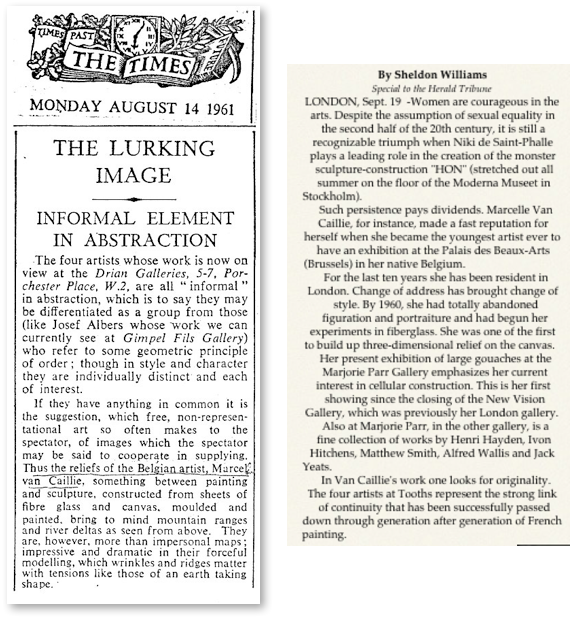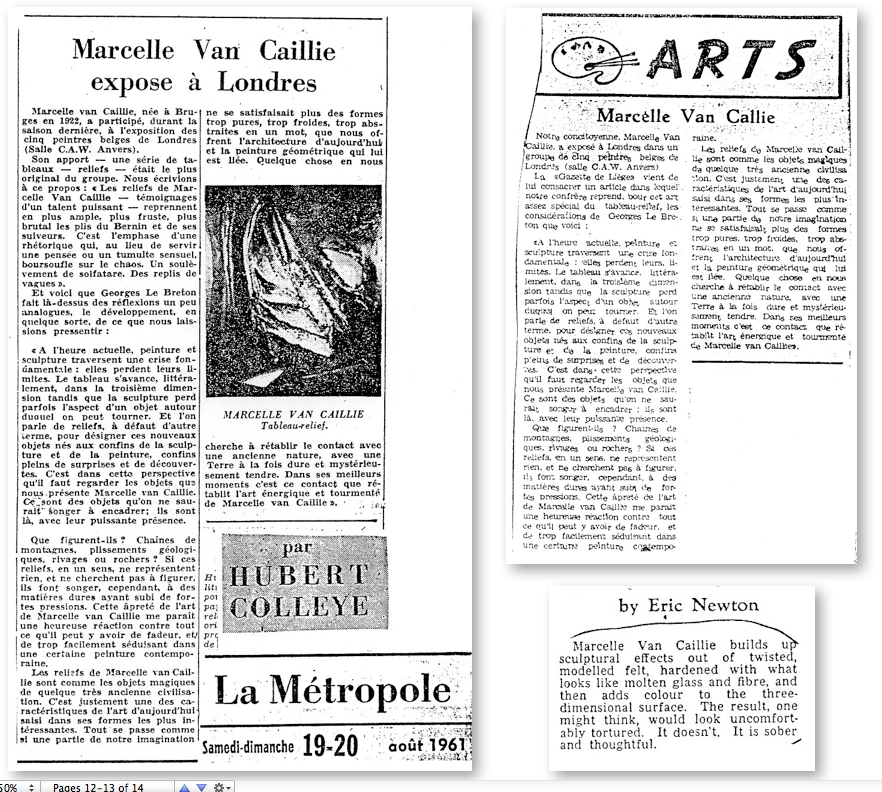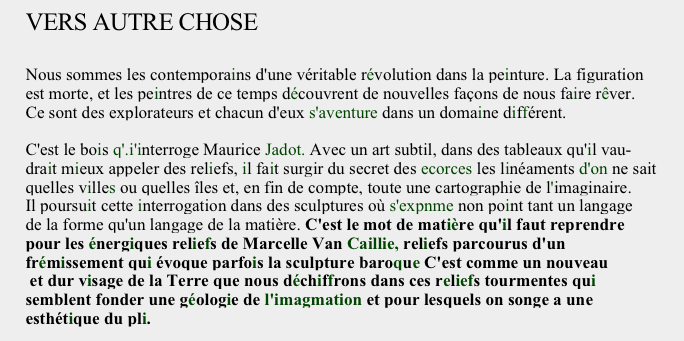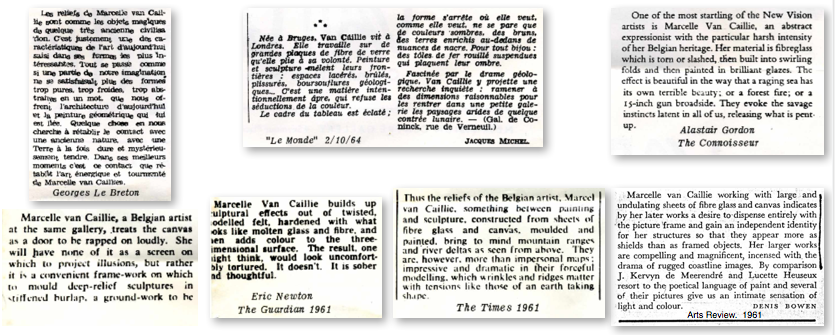Innovative, critics treated her with respect but had difficulty understanding her then although now, 50 years later,things have changed!
(See transcript, below)
Marcelle admitted that she painted to satisfy herself and the few people who had insight and understanding which included Pierre Rouve who wrote
Marcelle van Caillie, or the first woman in the moon-thus spake the all-knowing critics. But is it really fair to reduce her convulsive configurations to some sort of viewer’s digest of lunar landscapes? Would it not be more rewarding to go straight to her work avoiding this detour to Cape Kennedy? But such endeavour to explore the works on their own terms must not be limited to a flat inventory of artists‘ materials. Van Caillie’s restless reliefs are not the end of our journey, they are the beginning – launching pads necessary for the mind’s flight. And this flight is valid only when it soars high above them. What we care for are not glass fibres, but human vibrations.
And yet it is to the mute matter that we must turn, if we are to detect such human eloquence; matter is Marcelle van Caillie’s confessional and the confession is couched in the language of matter. The artist confides to the inert mass her unspoken tensions and lets it convey them in its own vocabulary – hence the disturbing presence of matter that articulates human states of mind moulding them in mounts of dignity and valleys of depression, in living glitter and leering lacerations. This is the miracle : matter, the insensitive, has become a seismograph of sensations. Matter that knows no pain exudes pain.
This is also the difference between Marcelle van Caillie and a host of artists who have placed their faith in brute matter:some, like Tapies, have soon bent its independence under a beautifying yoke. Others have followed Dubuffet’s lead and have reduced its alphabet to a few letters capable of conveying only baby talk and infantile emotions. Marcelle van Caillie is seldom tempted by such inverted sophistication : she dares to be crude only to be true.
And once again she seems to have reconciled conventional contradictions :tactile crudity blends with visual refinement. But refinement does not mean superficial exquisiteness, it means emotional subtlety. There is place for subtlety even in the most
immediate outbursts: waving coagulations shiver and self-asserting columns sway imperceptibly. But these are not aesthetic embellishments imposed from the outside by a matchful artist: they are born within van Caillie’s epos of martyred matter.
There matter and space fight a battle of life and death – and what we calmly call reliefs arc the battlefields of the palpable struggling against the intangible. This is why they can convey so fully human pain that has other roots and takes other names but is always checked upsurge, broken hope, self-inflicted wound. All this is said by the suffering surface oppressed by the heavy load of the invisible.
Space is the enemy of matter. It is the cruel void where nothing is and yet nothing else is allowed to be. Still, it is only through this wresting with mass that space will emerge from its nothingness to become perceptible, piercing and powerful. Yielding space is triumphant space. But the battle is nevertheless long between the vulnerable surface craving to grow into mass and the elusive vacancy that weighs inexorably over it. Matter becomes the matrix of this turgid tussle : it wriggles and ripples, slashed and scarred but stubborn. Then the invisible oppressor retreats only to curl and flow and flutter in its regeneration. And Marcelle van Caillie does not only mould the martyrdom of matter. She also portrays the birthpains of space.
PIERRE ROUVE THE ARTS REVIEW 28/11/1964
CRITICS
Innovative, critics treated her with respect but had difficulty understanding her then although now, 50 years later, looking easily saleable. She admitted that she painted for herself and for the few who had understanding. Like the words of Tchaikovsky “never troubling myself as to what the public would think of my work”. Among the few she included Pierre Rouve who wrote ‘And yet it is to the mute matter that we must turn, if we are to detect such human eloquence; matter is Marcelle van Caillie’s confessional and the confession is couched in the language of matter. The artist confides to the inert mass her unspoken tensions and lets it convey them in its own vocabulary – hence the disturbing presence of matter that articulates human states of mind moulding them in mounts of dignity and valleys of depression, in living glitter and leering lacerations. This is the miracle : matter, the insensitive, has become a seismograph of sensations. Matter that knows no pain exudes pain.’
As she left Belgium so she progressed from portraiture to the freedom of abstract. From the safety of craftsmanship she embraced the dangers of the unknown which might lead anywhere and which is the province of the true artist. To some extent this recapitulated the experience of her hero, van Gogh, when he moved from the North to the intensity of light in the South of France. As true art is always moving a simple easily recognisable style may not be obviously apparent. Once an artist becomes satisfied and knows what can be done, the temptation is to produce a large repeating series which delights dealers. However this activity is more akin to craft than art. Apart from a later small series of gouaches for the Marjory Parr Gallery, Marcelle did not follow this route and did not seek or achieve great commercial recognition. Experimental and innovative, she disdained the prevailing provincialism of the commercial art market. They reciprocated and ignored her which is not surprising as the number of works are small, mostly abroad, and are not meaninglessly repetitive as was the norm of her contemporaries. This accounts for her being virtually unknown to the art market. even now in 2015. HAS







Pingback: INTERVIEW- DR SANFORD REMEMBERS MARCELLE VAN CALLIE – O.ver_T.he_T.op_ART